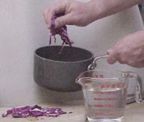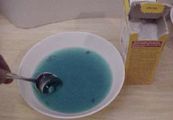![]()

|
|
|
The Archive List |
|
Do you have a comment or response to this activity, submit it to the Do Science bulletin board. |
 Great for Science Fair projects! |
|||
|
While You're Waiting for the Food to Come
click on the book cover above or on either cover version. |
![]()

What's the solution? Acid, base or neutral.

Ingredients:
 -Red
Cabbage
-Red
Cabbage
-Some water
-Baking-soda
-Vinegar
-Strainer
-Two white or clear bowls
-Mixing variations
A blender
or a sauce pan and stove
The Recipe:
1) Chop-up a handful of cabbage.
2) Now, make some cabbage juice! You can do it one of two ways:
i) Drop the chopped-up cabbage into a saucepan and add a cup or two of water. Heat until the water is a nice purple color. Remove from heat and let cool.ii) Drop the chopped-up cabbage into a blender and add a cup or two of water. Blend until the water is a nice purple color.
3) Once you have your purple juice, pour some into each of your two bowls. If you don't want any cabbage chunks floating around, pour your juice through a strainer.
 4)
Drip a few drops of vinegar into one bowl and watch what
happens
4)
Drip a few drops of vinegar into one bowl and watch what
happens
5) Sprinkle a little baking-soda into the other bowl andatch what happens
6) Optional:
-Try sprinkling some baking-soda into the juice/vinegar bowl and watch what happens.
-Try dripping some vinegar into the juice/baking-soda bowl and watch what happens.
7) Try other variations of mixing your vinegar and
baking-soda or try adding other liquids or chemicals.
liquids or chemicals.
Food for Thought:
Everything is made of chemicals and chemicals can be sorted into various categories. Some chemicals are acids. Some chemicals are bases. And some chemicals are in between acids and bases and are called neutral.
Red cabbage juice has an interesting property, it changes
colors depend if it is exposed to an acid or a base (cabbage
juice is known as an acid/base indicator). Cabbage juice is
naturally neutral. When it is neutral, it is a purplish
color. If an acid is poured into it, it will turn reddish.
If a base is added, it turns blue or greenish. Vinegar makes
your juice turn red, so vinegar is an acid.
Baking-soda makes it turn blue or greenish, so baking-soda is a
base.
makes it turn blue or greenish, so baking-soda is a
base.
By mixing an acid to a base (like when you added vinegar to your baking-soda and juice mixture), you made your solution become more an acidic. As you add acid, your solution changes from a base (blue/greenish) to a neutral solution (purple) and finally to an acidic solution (reddish). The opposite is true, when you add a base to an acid solution.